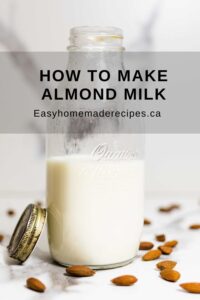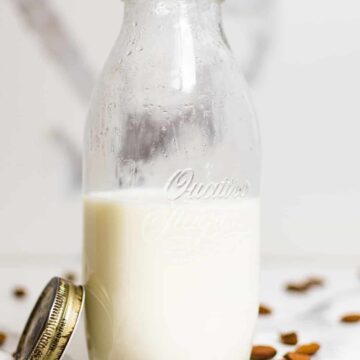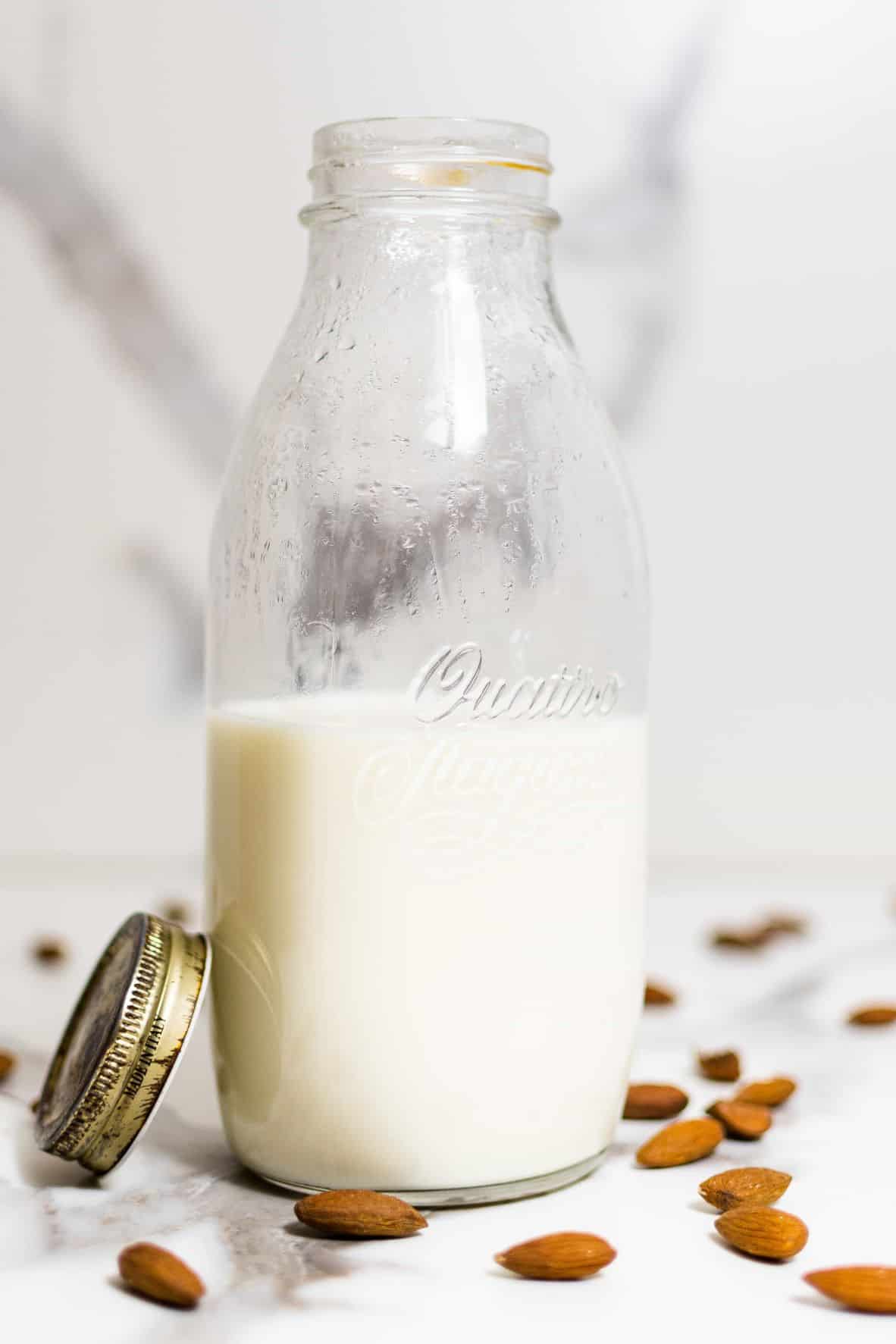While I enjoy the convenience of store-bought almond milk, it's also exciting to make almond milk at home! Almond milk is a great non dairy substitute wherever you would use cow's milk.
This recipe on how to make almond milk lets you adjust the quantity of sweetness and flavor infusion, as well as the thickness. When I want homemade dairy-free milk, this is my go-to.
Jump to:
- Ingredients Needed to Make Almond Milk
- Substitutions and Variations for Homemade Almond Milk
- Instructions on How To Make Almond Milk
- How to Store Almond Milk
- Is Almond Milk Healthy?
- How To Make Homemade Almond Milk Cheaper Than Store-Bought?
- Equipment Needed to Make Homemade Almond Milk
- How To Store Homemade Almond Milk
- Food Safety
- More About Guest Blogger
- Other Recipes
- Pin it Here
- Recipe Details
- Comments

Making your own Almond Milk doesn't need to be restricted to any season. Almonds are widely available and inexpensive, and this almond milk recipe is simple to prepare.
Almond milk is a great substitute for cow's milk because it may be used in many of the same ways. Consider smoothies, lattes, baking, and a variety of other options.
If you like almonds, then you will love this Almond Tart or these Amaretto Cookies which are so easy to make.
Ingredients Needed to Make Almond Milk
It's really simple to make almond milk because it requires only two ingredients, 10 minutes, and a blender! Basic ingredients include:
- Soaked Raw Almonds
- Water
- Vanilla Extract (Optional)
- Sweetener (Optional)
You have total control to add flavor or sweetener in this recipe.
Substitutions and Variations for Homemade Almond Milk
- Vanilla Extract - you can eliminate the vanilla extract or you can substitute another extract like almond extract to boost the flavor of the almond
- Sweetener - you have total control to add sweetener or choose a sweetener of your preference like honey, date syrup, stevia or maple syrup
- Flavor - Add cocoa powder for a chocolate twist or any other flavor booster like finely ground dried fruits, e.g. dried strawberries, dried blueberries, etc.
Instructions on How To Make Almond Milk
How Long Do You Need To Soak The Almonds?
I prefer soaking almonds in cold water overnight, although you could get away with 4 hours. Alternatively, soak almonds in extremely hot water for 1-2 hours.
Instructions
To make homemade almond milk, soak almonds in cold water overnight.
The water is then emptied, and the almonds are combined with new water, salt, and any extra ingredients in a blender.
After blending for 1-2 minutes, the milk is transferred into a mixing dish through a nut milk bag. The liquid is then squeezed out completely.
Can You Do Anything With The Leftover Almond Pulp?
Yes! Place the remaining almond pulp (also known as almond meal) on a baking sheet and bake at 200 degrees Fahrenheit for 2-3 hours, or until dry. Then it may be used as a topping for yogurt or chia pudding, as well as in homemade granola and baking preparations.
You can also save the almond pulp to use as almond flour by laying it out on a baking sheet to dry. Once dry remove the clumps by placing it in a food processor and grinding it evenly into a fine powder.
How to Store Almond Milk
The length of time it lasts will be determined by a number of things, including how well you disinfect your equipment, the freshness of your ingredients, and the temperature of your fridge.
On average, we find that homemade almond milk lasts 4-5 days.
If it goes sour before then, be sure to properly disinfect your equipment by running it through the dishwasher or pouring hot water into your jars (make sure the jars aren't too cold when you do this or they may shatter). Also, soak your almonds overnight in the refrigerator rather than at room temperature.
Is Almond Milk Healthy?
Not only is almond milk healthy, but making your own Almond Milk means that you will have milk that is:
- Fresh
- Creamy
- a little nuts
- Versatile
- Moreover, it is quite tasty!
One of the most significant advantages of producing your own homemade almond milk is that you may avoid using preservatives or chemicals such as carrageenan, which is included in many store-bought products. Carrageenan is a seaweed derivative that thickens and stabilizes meals, but it can also induce inflammation and gastrointestinal discomfort in the body.
For persons with autoimmune diseases or sensitive digestion, producing your own almond milk at home may be a smart way to eliminate harmful ingredients.
What are the advantages of consuming almond milk over skim milk or another sort of milk? Here are a few examples:
- Because almond milk is dairy-free, it contains neither lactose or casein, both of which can cause digestive upset in up to 75% of the world's population.
- Almond milk can offer up to 6 grams of protein per serving if all of the nourishment from the almonds is dispersed into the homemade milk. (Approximately the same as 1 ounce of almonds.)
- Because of the nutrient-dense almonds, 1 cup of homemade almond milk may include up to 8% of your daily recommended calcium needs and 6% of your daily iron needs.
A nice tall glass of this milk will go perfectly with maple walnut cookies.
How To Make Homemade Almond Milk Cheaper Than Store-Bought?
The benefit of creating your own almond milk at home is that you may choose the components. This handmade version contains no artificial sweeteners or additives! That also means you have control over how many almonds you use in this dish.
I recommend using the ratio mentioned in the downloadable recipe card below for the creamiest almond milk, but you may save money by using less almonds to water. When I prepare almond milk for breakfast or smoothies, I frequently use only ½ cup of almonds in 4 glasses of water, making my handmade version much more economical. It also tastes better than anything I've ever bought in a shop! I'm hoping you'll agree.
Equipment Needed to Make Homemade Almond Milk
Equipment can have a big impact on how a recipe turns out. Glass Jars with lids come in handy for keeping handmade nut milks, and this is my preferred nut-milk bag.
This brand of raw, organic almonds is also recommended. When straining almond milk, I prefer to strain it into a big measuring basin so that it can be poured into a storage container without spilling.
How To Store Homemade Almond Milk
Homemade almond milk may be stored in the fridge for up to three days, although it tastes best fresh. As a result, I don't advocate preparing a huge quantity or more than you'll need in a couple of days. And because it's so simple to produce when required, there's really no reason to create more!
Food Safety
Note that the storage guidelines provided on this page and site are estimates from personal experiences. We are all adults and as an adult you are responsible to ensure that the food you eat is safe to eat. Since, I'm not a food safety expert, you are responsible to review your local guidelines on food storage prior to storing any food left-overs.
Remember to:
- Not use the same utensils on cooked food, that previously touched raw meat
- Wash hands after touching raw meat
- Don't leave food sitting out at room temperature for extended periods
- Never leave cooking food unattended
- Use oils with high smoking point to avoid harmful compounds
- Always have good ventilation when using a gas stove
For Canadian Guidelines check the Government of Canada Food Safety Guidelines or see more guidelines at USDA.gov.
More About Guest Blogger
About Imsen
Guest Blogger and Recipe Developer at Salted Caramel Girl
My name is Imsen and I started this food blog as a way to express my love to food and to share my recipes with the others.
I dedicate most of my time on cooking and developing new recipes to provide you with trust-worthy and tested recipes.
Other Recipes
Pin it Here

Recipe Details

How to Make Almond Milk
Ingredients
- 1 cup almonds soaked overnight in cold water or 1 to 2 hours in boiling water
- 4 cups purified water
- 1 teaspoon sea salt
- 4 whole dates or 1 tablespoon maple syrup or honey (optional)
- 1 teaspoon vanilla extract optional
Instructions
- In a high-speed blender, combine the soaked almonds, water, salt, and any additional add-ins (optional) until creamy and smooth. Allow it to run for at least 1-2 minutes to get the maximum flavor from your almonds.
- Strain through a nut milk bag, cheese cloth or, my personal preference, a thin dish towel. Simply place a clean dish towel over a mixing bowl, pour in the almond milk, collect the corners gently, and raise up.
- Squeeze until all of the liquid has been removed. Save the pulp for adding to baked items or discard it.
- Refrigerate the milk in a container or covered bottle. Will keep for up to 4-5 days in the refrigerator, but is best when fresh. Shake vigorously before drinking, since it has a tendency to separate.











Comments
No Comments